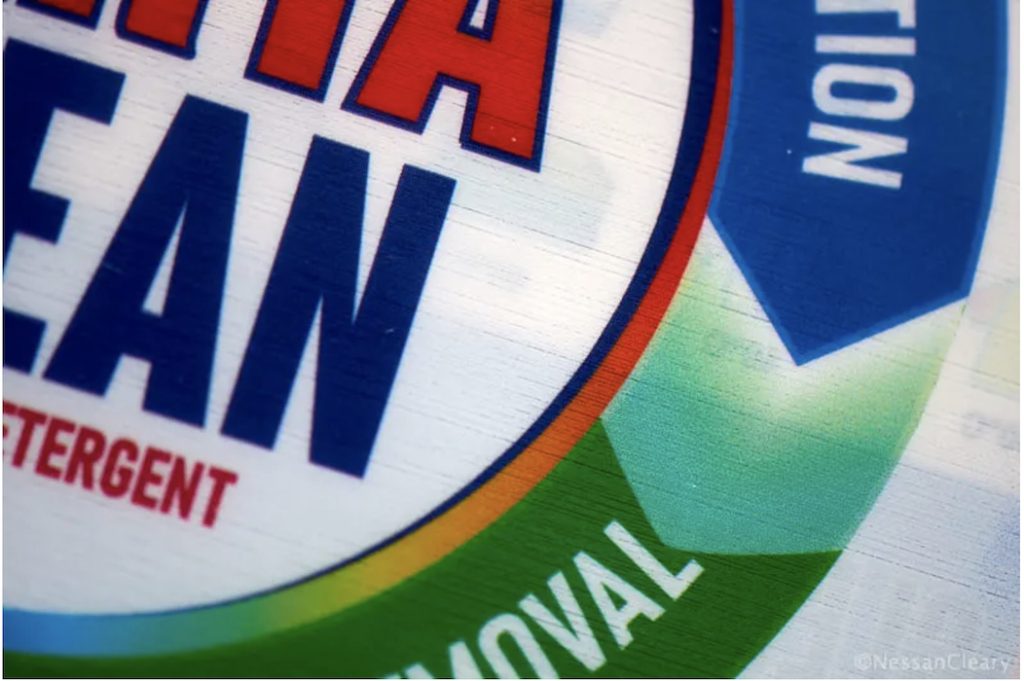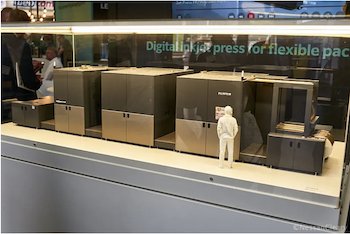
Fujifilm used the Interpack show in Dusseldorf, Germany, to officially launch its Jet Press FP790 inkjet press, which has been designed to print to flexible film for packaging.
This is a single-pass web-fed inkjet press using water-based inks. The press takes flexible films, namely PET and BOPP, from 12 to 40 microns. It can take web widths from 520 to 790 mm with a printing width of 753.2 mm. Manuel Schrutt, head of Packaging for Fujifilm Graphic Communications EMEA, says that the press can print on the surface of the films but that Fujifilm is focussing on reverse printing, which protects the ink from scratching and accounts for around 85% of the market.
Much of Fujifilm’s marketing stresses that Fujifilm makes many of the most critical components in an inkjet press, including printheads and inks, which is all true, but not at all relevant in this case since the FP790 is actually a rebadged Miyakoshi MJP30AXF. This is not an exclusive arrangement and Miyakoshi will continue to sell its own press and already has one installed at Kanaoka Gravure, a large packaging printer based in Reiwa, Japan.
It is a big machine, with three main units. Starting from the unwinder, the first unit contains a corona unit and a flexo pre-coater that lays down a water-based primer, which is the key to printing to a non-porous substrate. The second unit contains the CMYK printbars. This unit also has a drying area, which mainly consists of hot air and infrared heating. The third unit prints two sets of white ink, complete with a final drying unit before the roll reaches the rewinder.
The printheads are Kyocera with 1200 x 1200 dpi, which is not a surprise since Miyakoshi has a great deal of experience working with Kyocera. There are seven heads for each of the six printbars. The press includes automatic registration control and missing nozzle compensation.
The ink is suitable for printing food packaging though it’s not entirely clear where the ink has come from. Schrutt says that the ink is from Fujifilm and that Fujifilm is building a brand new ink factory in the US for flexible packaging and that in future the ink will be manufactured at that facility. However, I’ve already reported last year that Toyo showed me samples printed with their ink on the Miyakoshi version of this printer. So it seems likely to me that both Miyakoshi and Fujifilm are probably still using Toyo ink. It certainly would not be an easy matter to switch to another ink supplier given the balanced interplay between the printheads, the drying system, primer, and substrates. It’s not that it can’t be done – and Fujifilm is certainly better placed than most vendors to develop its own ink – but it would delay time to market and add to the development costs.

Photo Fujifilm
The press can reproduce 90.5% of the Pantone color gamut with a delta E below 2 using CMYK. Schrutt says that there’s no need for additional colors such as orange and green, and that limiting the colors to four helps to reduce the running costs. The white ink can achieve 56-58% opacity. For now, Fujifilm is quoting a production speed of 50 mpm at 1200 x 1200 dpi for all colors including the white though I believe the press could run at up to 100mpm. Schrutt says, “We are still analyzing the press. So 50 mpm is our starting point. But of course, we have a plan to increase speed.” He adds, “We are starting now to optimize the ink laydown and drying temperature and different substrates to understand how far we can stretch this. We know we have a wide window but without having customer testing in the field we can’t say for sure.” Schrutt adds, “Some substrates might go faster than others.”
Fujifilm has also with worked other suppliers to test compatibility with the FP790. This includes Henkel Adhesive Technologies where the two companies have verified adhesion properties and lamination performance in post-press production. Fujifilm has also worked with Nordmeccanica to test its Simplex range of two-layer laminating machines for solvent-less adhesives.
Schrutt explains, “For us, it was absolutely crucial to have a plug-and-play product. So you can put the roll on the machine and print it and go to a downstream process without changing anything, so it works with the same adhesives and lamination as with flexo. We are targeting flexo volumes. We have a very strong TCO to position us in the mainstream volumes of flexo to convert flexo to digital.”
He says that it’s difficult to define the sweet spot for this press because it depends on the overall productivity, which itself depends on the finishing solutions that each converter has for the applications they are printing. However, he suggests that jobs from 1 to 10,000 sqm are a good starting point, possibly higher depending on how well-optimized the finishing is.
Schrutt says that there has been very positive feedback from potential customers, noting, “We can outperform flexo quality and are closer to rotogravure, which also gives us an opportunity to take work that is only on a rotogravure press as there’s no shorter run option that can match the quality, and with faster time to market.” He adds that the inkjet press is more sustainable and uses less energy.

Photo Nessan Cleary
It’s worth saying that the samples that I picked up at Interpack were reasonably good, with quite sharp text down to small point sizes and a good range of colors. They’re not as clean as the folding carton samples printed on the Jet Press 750s, which I’ll come back to in a more general report from Interpack. Then again, most consumers probably won’t photograph their packaging with a macro lens.
Hybrid Software & Global Graphics DFEs & workflows
Fujifilm has previously announced a partnership with Hybrid Software to develop a ‘Smart Digital Front End (DFE) and unified workflow solution developed specifically by Hybrid Software’ according to the accompanying press release. However, Miyakoshi has already built a DFE, also using components from Global Graphics’s SmartDFE, specifically put together to help gang short-run jobs together to make them more cost-effective. So it seems likely to me that Fujifilm’s XMF Packaging DFE is actually working in conjunction with the Miyakoshi-developed DFE, combined with other elements from Hybrid Software including Packz and Cloudflow, which would make for an extremely effective packaging workflow.
It’s also interesting to note that a decade or so ago when digital label presses first started appearing, many press vendors turned to Esko as its software was widely used by the packaging customers they were trying to reach. In the intervening years, Hybrid Software has assembled a wide portfolio of packaging tools and become part of the Hybrid Software Group, which also includes Global Graphics. I’ll get around to covering the SmartDFE, which offers an extraordinary range of features, in the next few weeks.

There is currently one Fujifilm Jet Press FP790 press installed and running at Maruto, a large packaging printer in Japan that mainly serves the food and pharmaceutical markets. Fujifilm is in the process of moving a second FP790 from its US demo site to the first US customer, and there is a third FP790 that’s just about to ship to Birmingham, UK for the European beta. Spreading the beta sites around like this helps ensure that neither Fujifilm nor its customers will be caught out with substrates that might be more prevalent in one market than another.
Schrutt anticipates that the beta testing will take three to six months with commercial availability immediately afterward later this year. He adds, “We have way more customers than we had expected to have for the FP790. It’s in the high double digits.”
You can find further details on the FP790 from fujifilm.com and on the MJP30AXF from miyakoshi.com
First published on 10th May 2023 in the Printing and Manufacturing Journal www.nessancleary.co.uk and republished by permission here.











